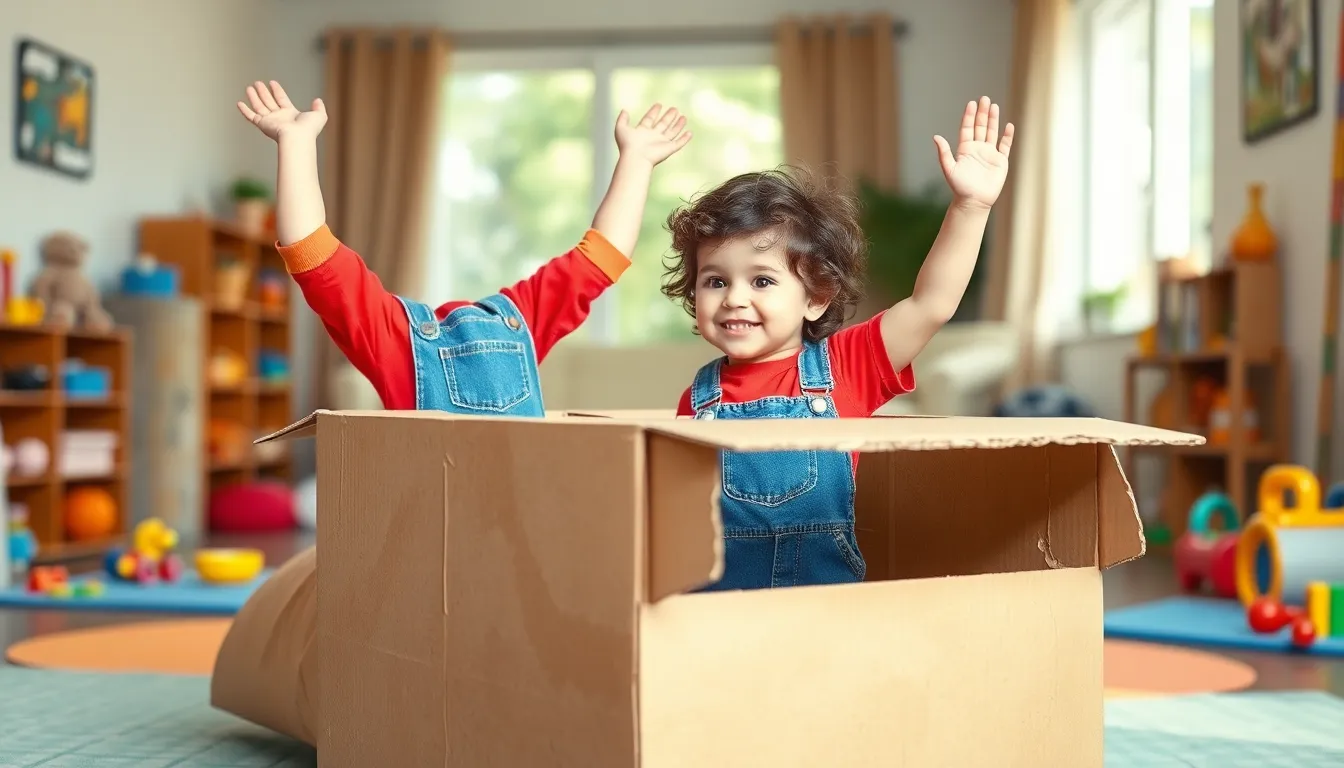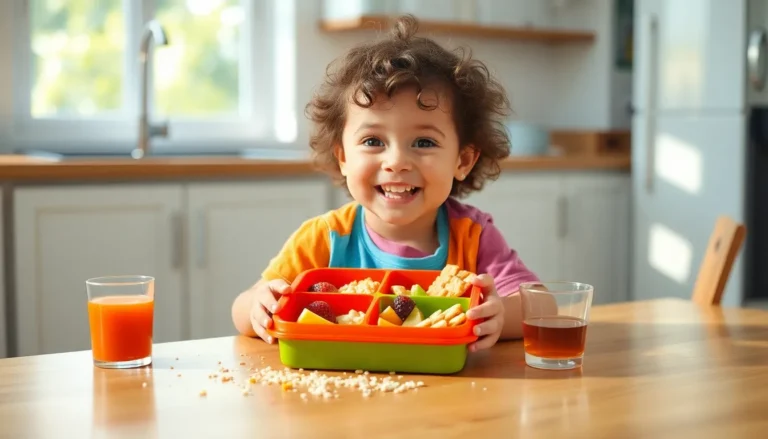Table of Contents
ToggleEvery parent knows that toddlers have an uncanny ability to transform a simple cardboard box into a spaceship, a castle, or even a dinosaur lair. Imaginative play isn’t just child’s play; it’s a vital part of their development. It sparks creativity, enhances problem-solving skills, and even gives parents a much-needed break. Who wouldn’t want to turn their living room into a bustling marketplace while sipping coffee in peace?
Benefits of Toddler Imaginative Play Activities
Engaging in imaginative play offers numerous benefits for toddlers. Development in key areas occurs through various forms of creative expression.
Cognitive Development
Imaginative play significantly enhances cognitive development. Children develop their problem-solving skills as they navigate play scenarios. They explore critical thinking while deciding how to use everyday objects in new ways. Pretend play encourages language acquisition by expanding vocabulary during role-playing. Cognitive flexibility arises as they adapt to different roles and situations. Overall, creative play enables children to think independently and boosts their creativity.
Social Skills Enhancement
Social skills flourish during imaginative play. Interaction with peers leads to improved communication skills as children express their thoughts and emotions. Collaborative play teaches turn-taking and sharing, vital components of social interaction. Role-playing situations encourage empathy as children learn to understand others’ feelings. Conflict resolution skills develop when they negotiate play scenarios. Such interactions create a foundation for healthy relationships as they grow.
Types of Toddler Imaginative Play Activities

Engaging in imaginative play can take many forms, promoting creativity and development in toddlers. Various activities nurture their abilities and spark new ideas.
Role-Playing Scenarios
Role-playing scenarios offer toddlers opportunities to step into different characters’ shoes. Common examples include playing doctor, chef, or superhero. In these scenes, children learn to express emotions and understand different perspectives. They often use costumes or props to enhance their play experience. Parents can encourage this type of play by providing simple costumes or everyday items like old clothes and utensils. This kind of interaction not only fosters language skills but also builds confidence and collaboration.
Creative Art Projects
Creative art projects allow toddlers to explore their artistic side while using their imagination. Activities such as finger painting, drawing, or crafting with recyclable materials stimulate creativity. Through these projects, children express their thoughts and feelings visually. Providing basic materials such as paper, crayons, and glue supports their art exploration. Engaging in various art forms encourages fine motor skills and critical thinking. Parents can join in the fun to further enhance the creative experience and share quality time.
How to Encourage Imaginative Play
Encouraging imaginative play involves creating an environment and providing resources that stimulate creativity and exploration.
Creating a Stimulating Environment
A stimulating environment invites toddlers to engage in imaginative play. Brightly colored decorations and open spaces allow freedom of movement. Natural light enhances mood and inspires creativity. Designated play areas help toddlers feel comfortable and safe while they experiment. Soft mats provide comfort during active play. Incorporating various textures and visual elements captures children’s interest. Parents can rotate toys regularly to keep the environment fresh and exciting. Incorporation of nature, such as plants, fosters curiosity about the world. Inviting friends for interactive play can enhance social skills, accommodating shared imaginative experiences.
Providing Appropriate Materials
Appropriate materials fuel imaginative play and encourage creativity. Simple household items, like cardboard boxes and kitchen utensils, often spark innovative ideas. Dress-up clothes or costumes allow toddlers to immerse themselves in different characters. Art supplies, such as crayons and paint, offer opportunities for expression through creativity. Building blocks engage toddlers in construction and design challenges. Additionally, sensory materials, such as sand or water, enhance exploration and experimentation. Providing books with diverse stories broadens their imaginative horizons. Keeping crafting tools and art supplies accessible encourages spontaneous creativity. These materials not only inspire play but also foster cognitive and emotional growth in young children.
Safety Considerations
Safety is crucial when engaging toddlers in imaginative play. Parents must ensure that all play items are age-appropriate and free from small parts. Toys should meet safety standards to prevent choking hazards.
Supervision during playtime is essential. Parents can closely monitor activities to ensure children play safely and use materials correctly. Establishing clear boundaries helps toddlers understand what is acceptable during imaginative play.
Creating a safe play environment enhances the experience. Soft surfaces, like rugs or mats, can protect toddlers from falls. Removing sharp objects or breakable items from play areas minimizes risk.
Selecting safe props is necessary for imaginative games. Natural materials, such as blankets and pillows, can become fantastic play elements without posing danger. Avoid items with toxic substances or unsafe materials.
Incorporating safe outdoor spaces adds variety to imaginative play. Parents should check play areas for hazards, like uneven ground or sharp objects. Keeping a first-aid kit nearby provides peace of mind during outdoor activities.
Fostering communication about safety benefits toddlers as well. Discussing rules and potential dangers helps kids make better decisions while playing. Encouraging them to express their feelings creates a safer, more supportive environment.
Setting limits on creative activities maintains safety. For example, restricting access to certain materials, like scissors or paint, helps avoid accidents. Allowing freedom within safe boundaries promotes imaginative growth.
Following these guidelines ensures imaginative play remains enjoyable and risk-free. By prioritizing safety, parents can confidently encourage creative exploration in their toddlers.
Imaginative play is a vital component of a toddler’s growth and development. By engaging in creative activities, children not only enhance their cognitive skills but also build essential social abilities. Parents play a crucial role in facilitating these experiences by providing a safe and stimulating environment filled with diverse materials.
Encouraging role-playing and artistic projects fosters creativity and self-expression. These activities allow toddlers to explore different perspectives and emotions while developing confidence and communication skills. Prioritizing safety during playtime ensures that children can fully enjoy their imaginative journeys without risk.
Ultimately, nurturing a child’s imaginative play leads to lifelong benefits, paving the way for independent thinking and healthy relationships. Embracing these playful moments can create lasting memories and strengthen the bond between parents and their little ones.




